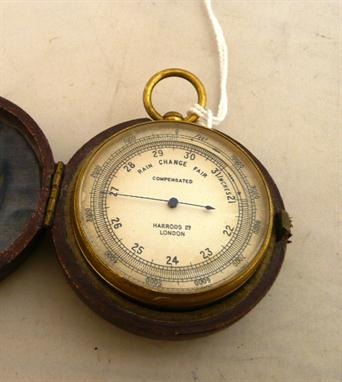A very rare mahogany cased aneroid barocyclonometer or `Typhoon Barometer` Schmidt & Ziegler, Remscheid, to a design by Jose Algue, Manilla, early 20th century The box opening to reveal Faura pattern aneroid barometer with 6 inch circular silvered register calibrated in both barometric inches and millibars and inscribed TYPHOON-BAROMETER by JOSE ALGUE S.J. Director of MANILLA OBSERVATORY, SCHMIDT & ZIEGLER, REMSCHEID to centre, within adjustable outer scale annotated for the Northern hemisphere with latitudes 0-25 opposing 25-32 grouped with appropriate pressure readings for different seasons to the lower half, the upper half annotated with typhoon predictions, the whole set into brass plate numbered 317, the lid of the box applied to the inside with patinated brass and glass CYCLOMETER with central bevelled glass plate scribed with direction arrows and applied with two pointers one engraved with scale 0-100 the other with pivoted direction indicator, the whole rotating within a circular plate annotated with the points of the compass and with repeat signature, the exterior of the box with shaped brass nameplate to top and visible dovetail joints to corners, 22cm wide, 12cm high. This remarkable instrument was the culmination of the efforts of two successive Jesuit Priest directors of the Manilla Observatory, Federico Faura and Jose Algue. The problem of predicting destructive typhoons, which took dozens of lives each year in the Phillipines, led to Faura`s research and eventual publication of his paper Senales precursoras de un temporal in 1882. He then went onto develop the `Faura` pattern barometer which through use of a carefully devised scale could predict with a fair degree of accuracy the proximity of a typhoon. Jose Algue, who succeeded Faura in 1897, undertook further research to devise a method of forecasting the direction from which a typhoon would approach. This led to the development of his `cyclonometer` or `wind disc`. The incorporation of both instruments into one unit was termed a `baroclclonometer`, examples of which were utilised throughout the Phillipines saving countless lives during the opening years of the 20th century. In 1912 Jose Algue was invited by the U.S. government to devise a version of his tried and tested barocylonometer for use in the Northern hemisphere in order to assist in the prediction of Hurricanes and Atlantic storms. In August 1912 he visited New York and Washington where it was agreed that a model calibrated for the Northern hemisphere would be made in Germany for trial onboard Connecticut flagship of Rear Admiral Osterhaus -commander of the Atlantic Squadron for U.S. Navy. By January 1913 Algue was in London where discussions regarding the production of further models in London took place. An account of his visit to New York was published in The New York Times August 18th 1912, and a review of the instrument was published in Popular Mechanics January 1913 issue. The current lot is probably from the very early series of German made models as specified for the order for the U.S. Navy. Another later model (dating to circa 1928) by H. Hughes & Son, London is in The National Maritime Museum collection in Cornwall.
60594 Preisdatenbank Los(e) gefunden, die Ihrer Suche entsprechen
60594 Lose gefunden, die zu Ihrer Suche passen. Abonnieren Sie die Preisdatenbank, um sofortigen Zugriff auf alle Dienstleistungen der Preisdatenbank zu haben.
Preisdatenbank abonnieren- Liste
- Galerie
-
60594 Los(e)/Seite
A mahogany barograph Negretti & Zambra, London, circa 1905 With four-part large diameter aneroid chamber within lacquered brass armature operating inked pointer for the clockwork driven rotating paper-scale lined drum, the patinated brass baseplate signed NEGRETTI & ZAMBRA, LONDON, beneath five panel glazed cover on cavetto moulded base with full width squab feet, 34cm wide. The firm of Negretti & Zambra are recorded in Banfield, Edwin BAROMETER MAKERS & RETAILERS 1680-1860 as being established in 1850 when a partnership between Enrico Negretti and Joseph Warren Zambra was formed. The firm became one of the most prolific makers of fine quality weather instruments and continued trading well into the 20th century. An identical example to the current lot is illustrated in Collins, Philip Barographs on page 86.
C19th Novelty Lighthouse Compendium Time Piece on circular slate base with gilt & bronzed brick effect column, pierced gallery, supporting silvered turret set gilt centred time piece with silvered chapter ring, Roman numerals, centigrade thermometer, gilt centred silvered aneroid barometer & Farenheit thermometer with domed & strapwork cap, turned knop finial, top section rotates on clockwork base, approx. 16 1/2" H on turned wooden base (2 KEYS IN OFFICE)
Mixed Instruments, including a bakelite office telephone, two wooden wall mounted telephones, calculating machines, cased MKII rangefinder by Watts, Elgometers, thermometers, two Otis Kings calculators, cased scale, Casella compensated barometer, in a stitched leather case (a/f), `Palantype` stenotype machine etc
An Oxidized Brass Military Clinometer by Short & Mason Ltd, London, 1909, No.4793, in a stitched leather case; A Compensated Pocket Barometer by Dollond & Aitchinson, London, with oxidised brass case, silvered dial and blue steel pointer, in original leather case; Set of Brass Postal Scales, on mahogany base, with weights (3)
-
60594 Los(e)/Seite











































